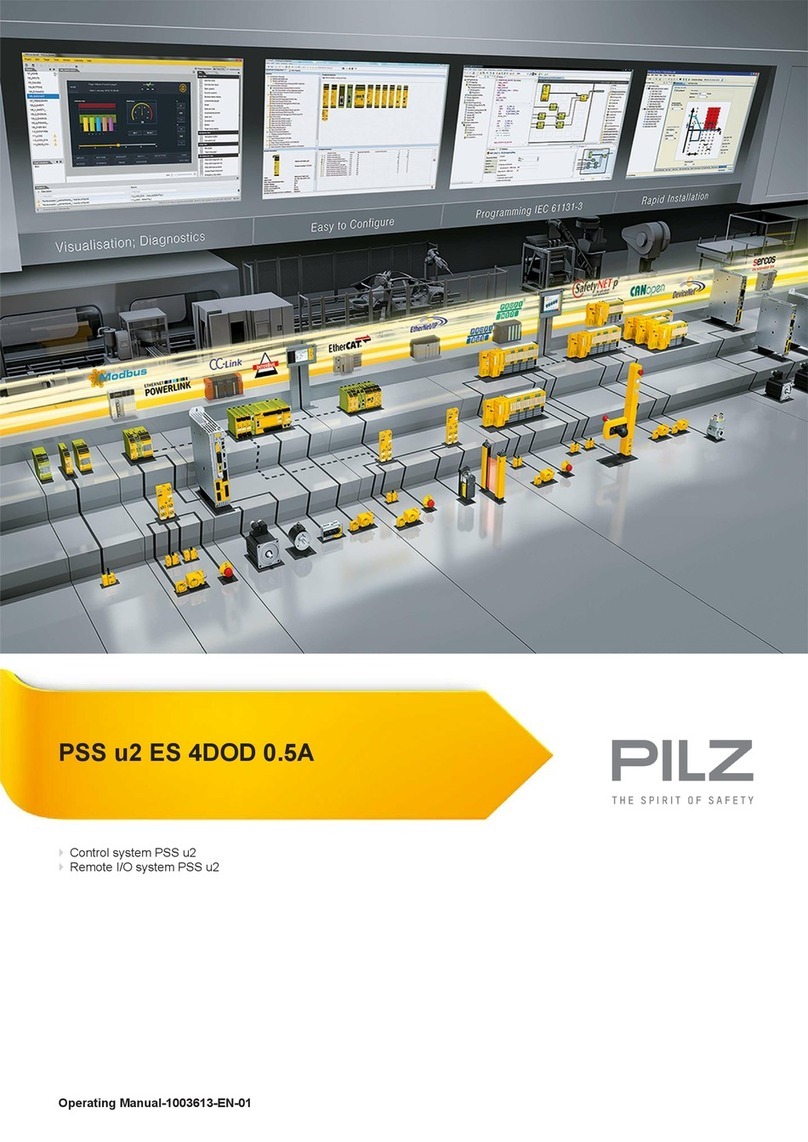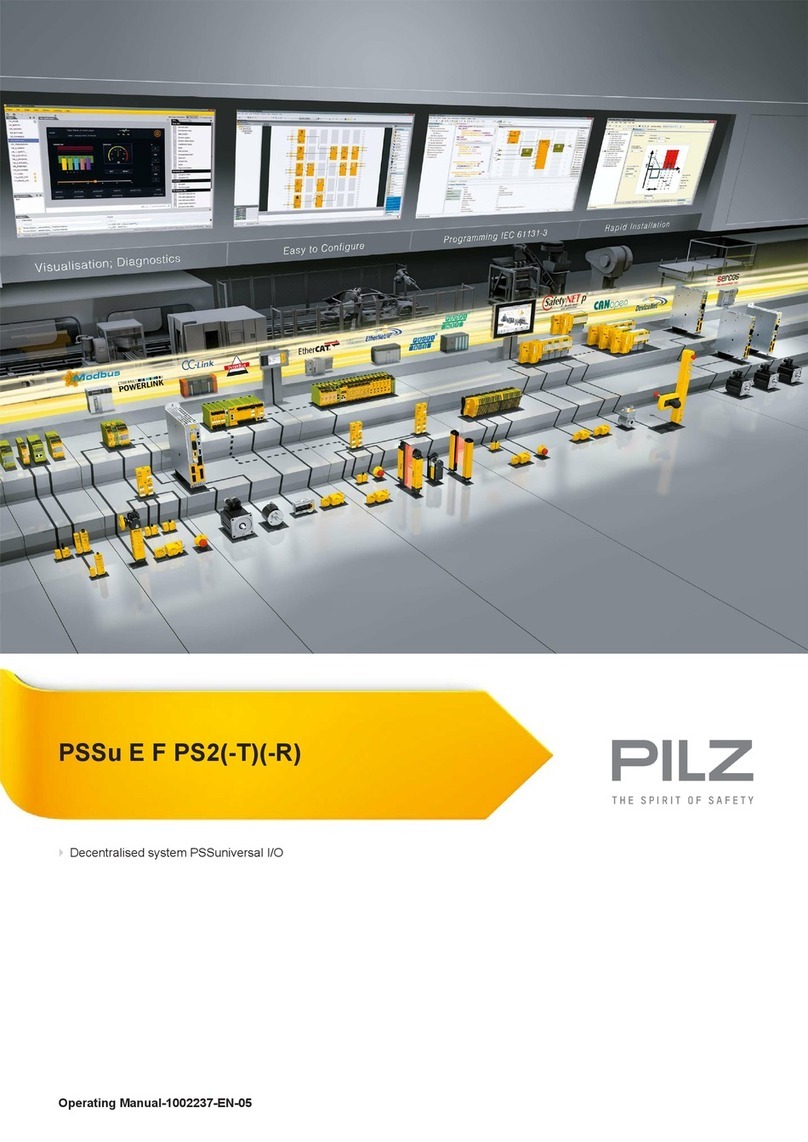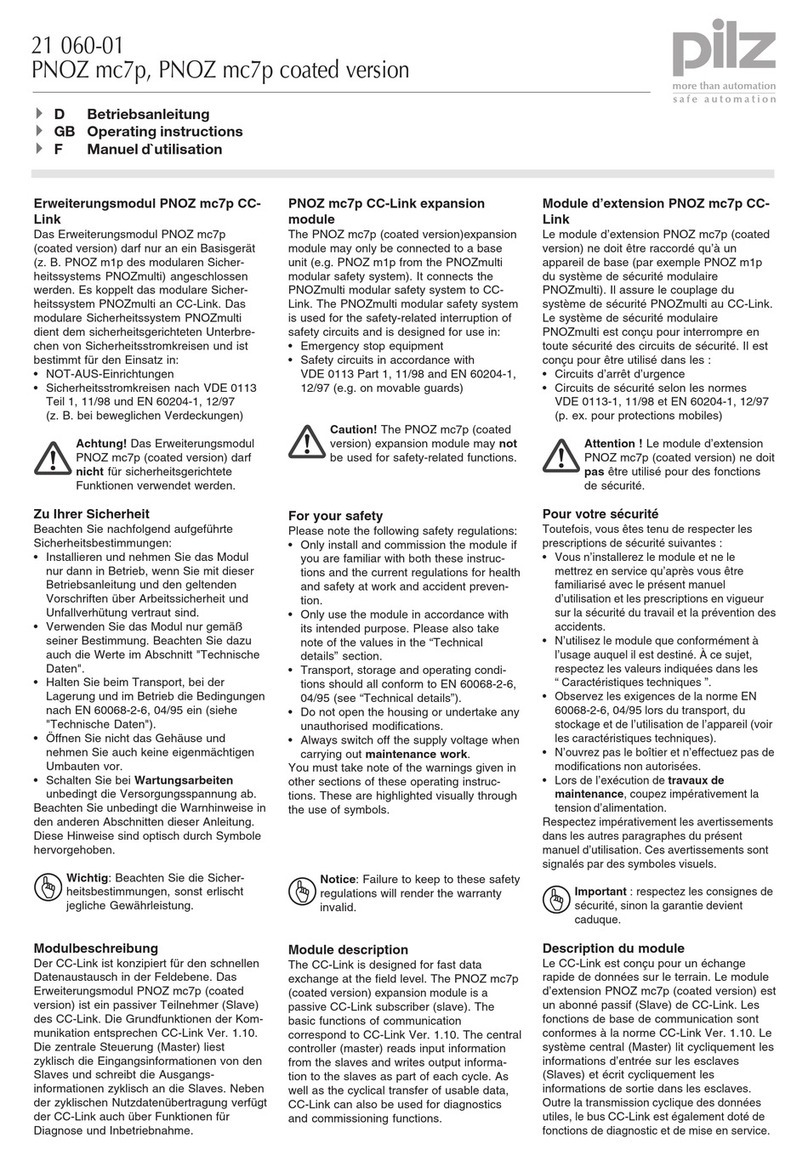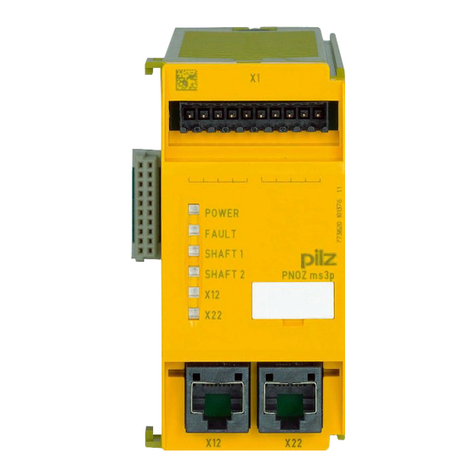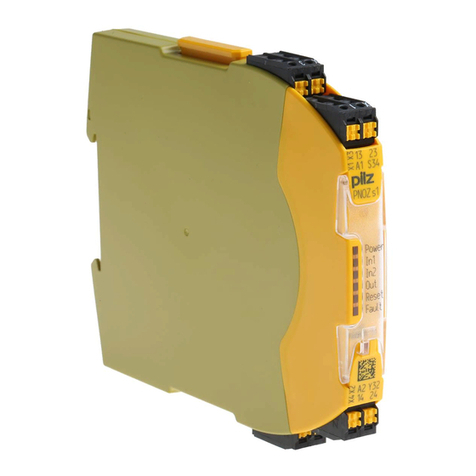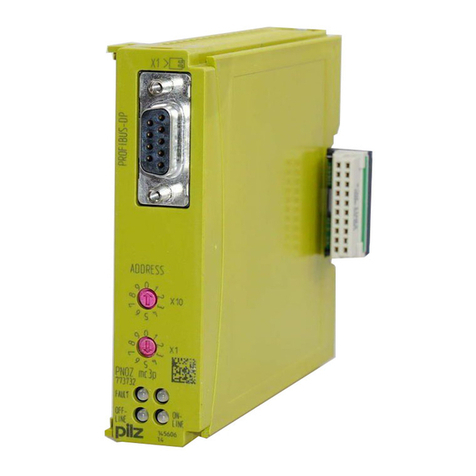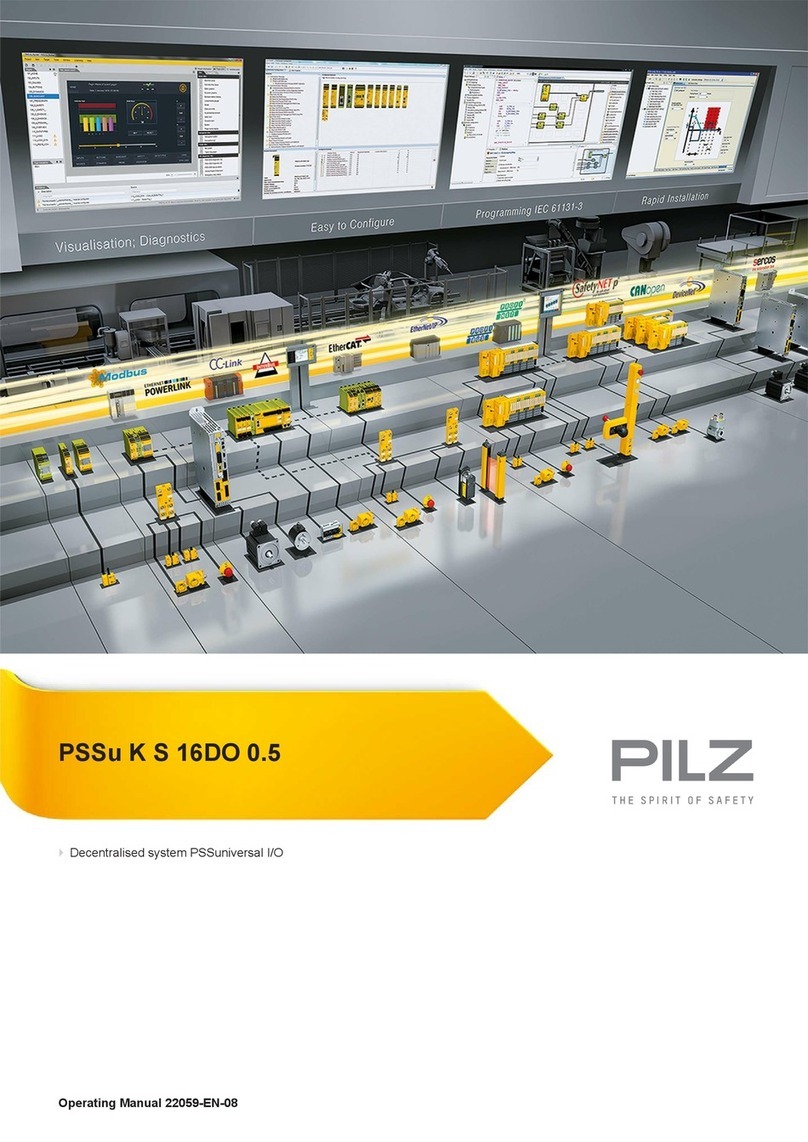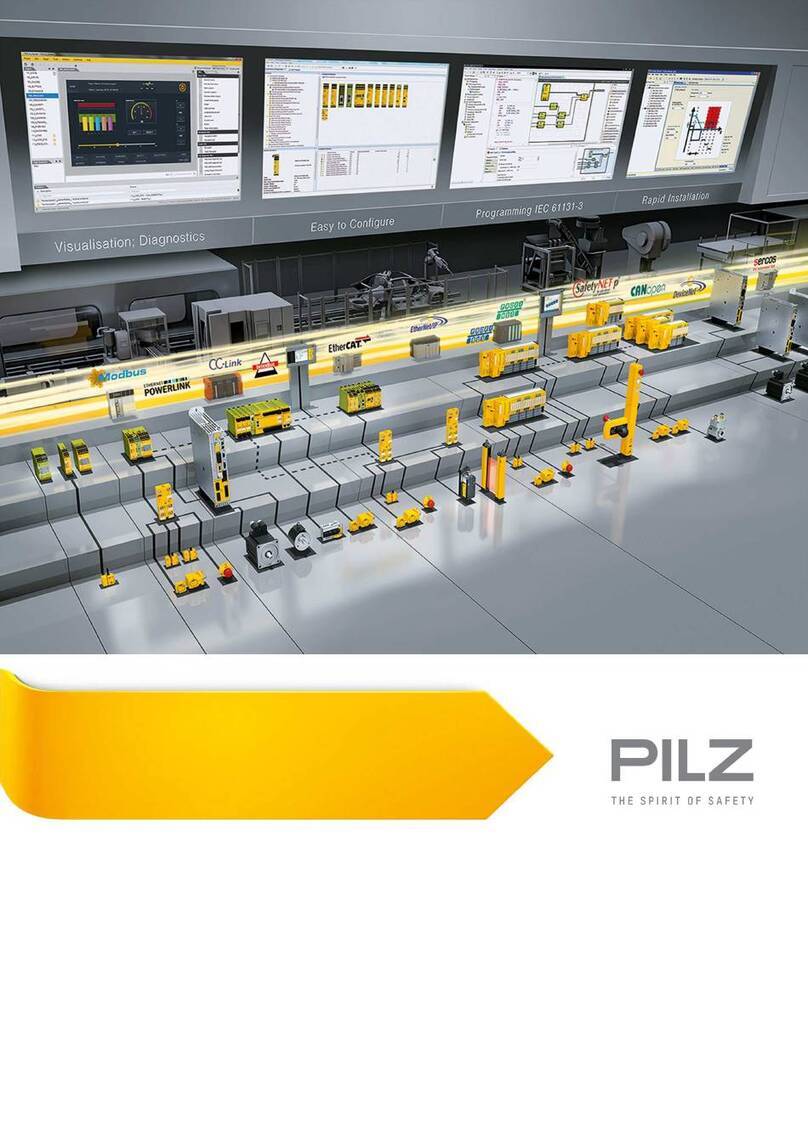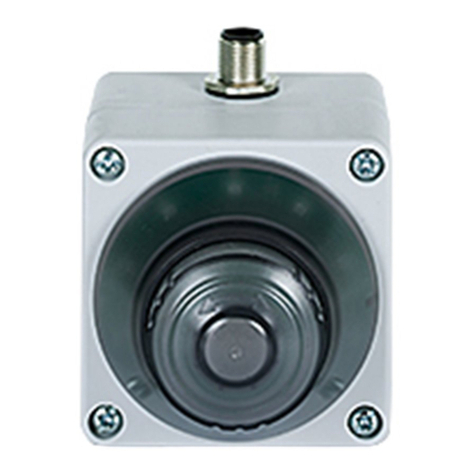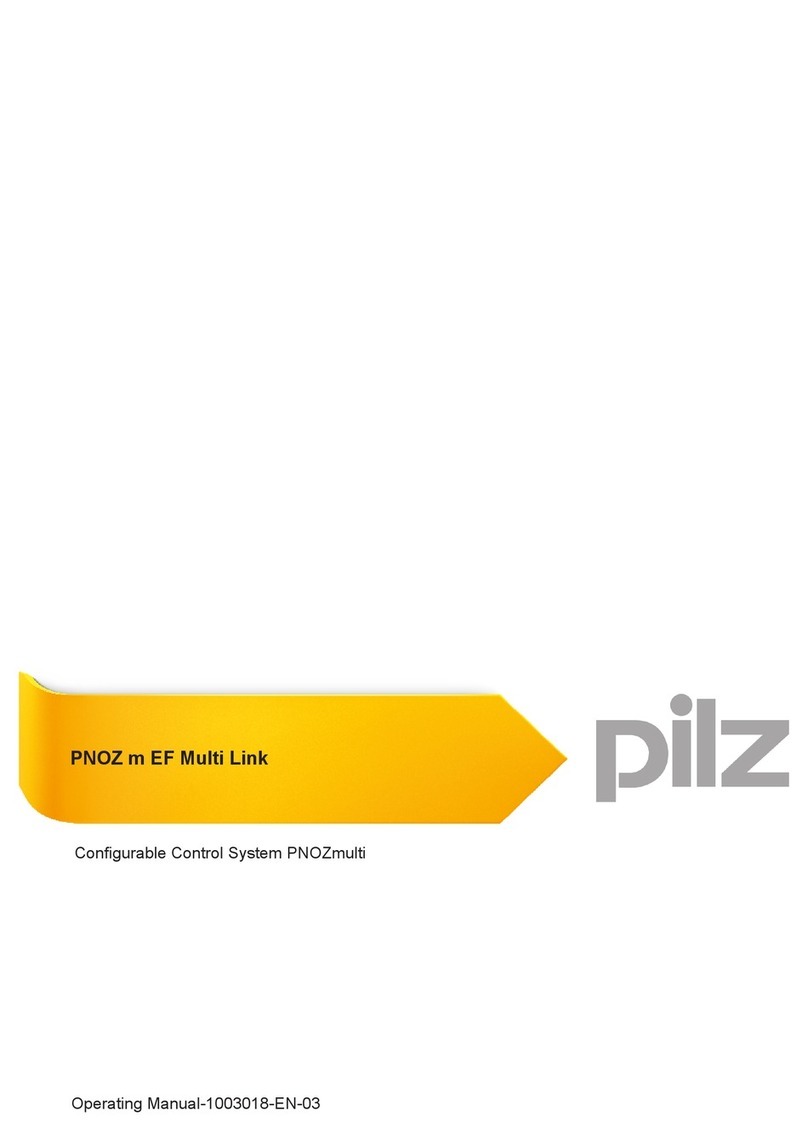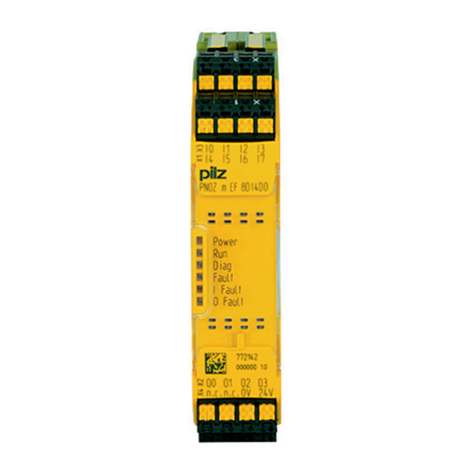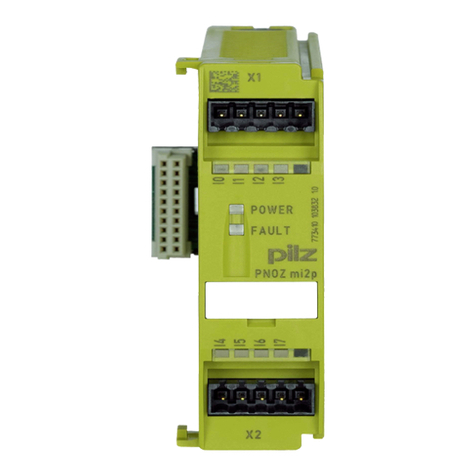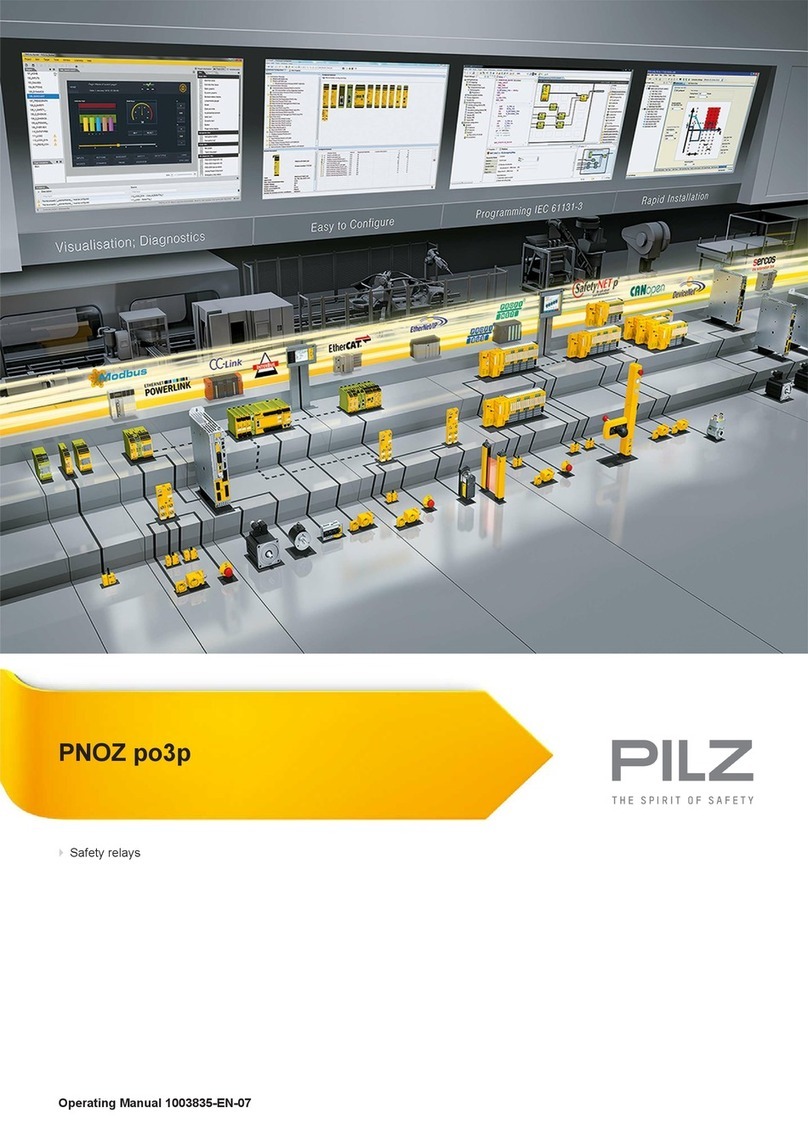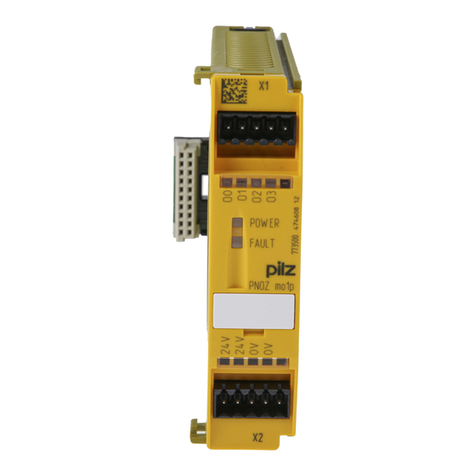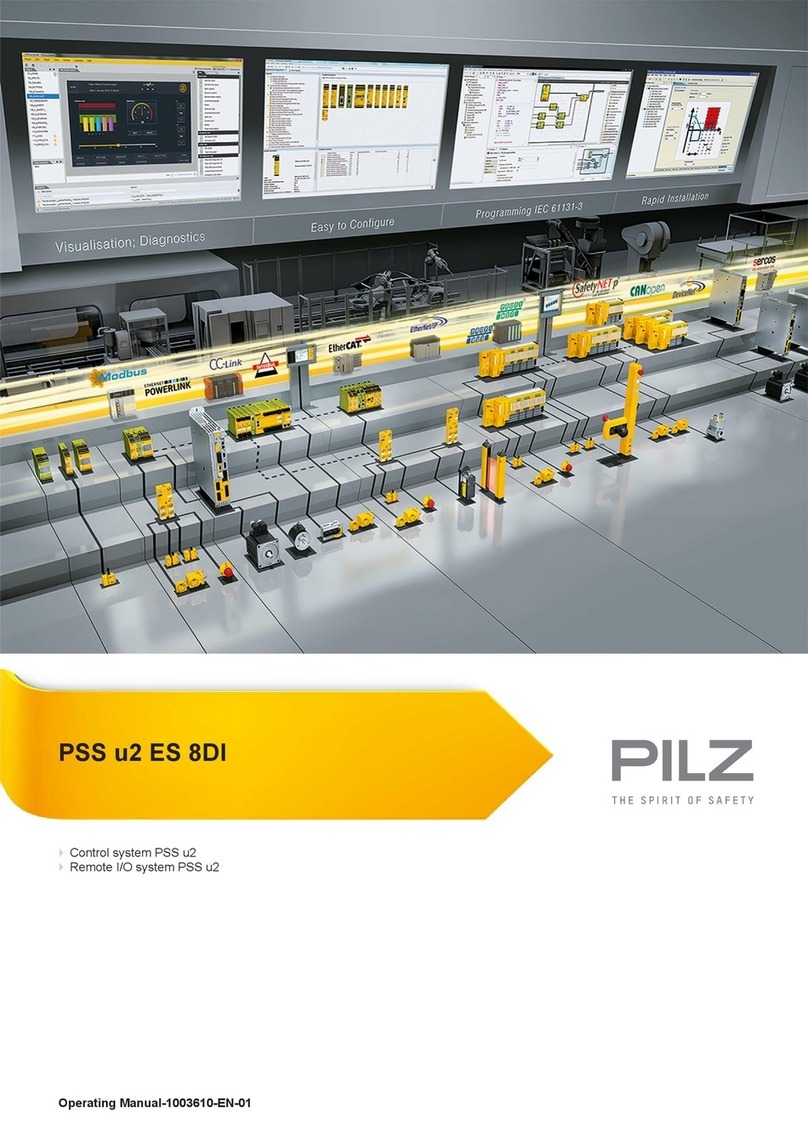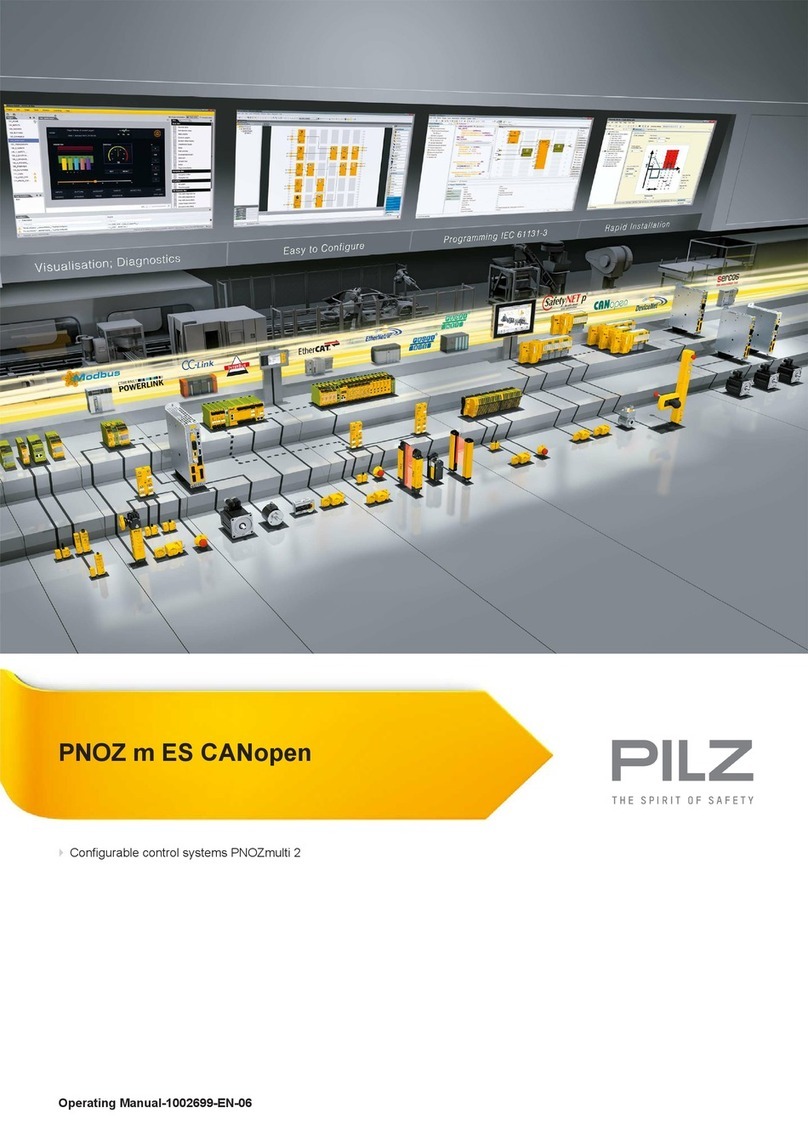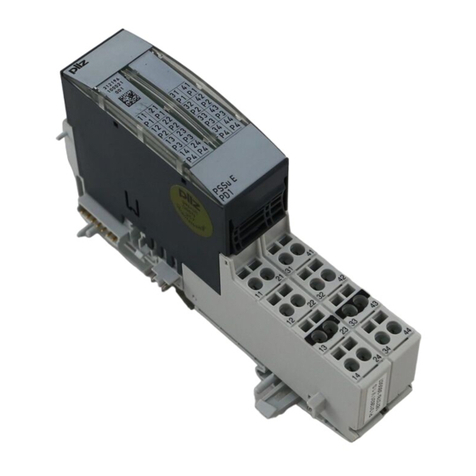
- 10 -
Descripción del funcionamiento
Modo de trabajo:
El supervisor de revoluciones PNOZ ms1p/
PNOZ ms2p puede supervisar la parada,
las revoluciones y la dirección de giro de
dos ejes, independientemente uno de otro.
El
PNOZ ms1p/PNOZ ms2p avisa al
dispositivo básico el estado de los valores
supervisados. Dependiendo del circuito de
seguridad cargado, se pueden transferir los
valores del dispositivo básico p. ej. a una
salida de relé del sistema de seguridad.
Para la recepción de los valores se pueden
utilizar codificadores incrementales y/o
interruptores de aproximación.
¡Información! En la ayuda online del
configurador PNOZmulti se describe
detalladamente la configuración del
supervisor de revoluciones
PNOZ ms1p/PNOZ ms2p.
Montaje del sistema de seguridad
Tenga en cuenta durante el montaje:
¡Atención!
Los componentes del autómata de
seguridad pueden resultar dañados
debido a una descarga electros-
tática. Procure una descarga de la
electricidad estática del propio
cuerpo, antes de tocar el autómata,
por ejemplo tocando una superficie
conductora con descarga a tierra o
llevando puesta una muñequera
con descarga a tierra.
• El sistema de seguridad ha de montarse
en un armario de distribución con un
grado de protección IP54 como mínimo.
•Monte el sistema de seguridad en una
guía portadora horizontal. Las rejillas de
ventilación deben señalar hacia arriba y
hacia abajo (véanse las instrucciones de
uso del dispositivo básico PNOZ m0p,
PNOZ m1p, PNOZ m2p). Una posición
de montaje diferente puede causar la
destrucción del dispositivo.
• Fijar el sistema de seguridad a una guía
normalizada con ayuda de los elementos
de encaje en la parte trasera. Colocar el
sistema de seguridad, recto, en la guía
normalizada, de tal manera que los
resortes de puesta a tierra del sistema,
hagan presión sobre la guía.
• Para cumplir con los requerimientos
CEM, la guía debe estar unida, con baja
impedancia, a la carcasa del armario de
distribución.
Conectar el dispositivo básico y los
módulos de ampliación
Los módulos se conectan con puentes
insertables. Pueden conectarse como máximo
8 módulos de ampliación y un módulo de bus
de campo en un dispositivo básico. De ellos,
están permitidos como máx. 4 supervisores de
revoluciones PNOZ ms1p/PNOZ ms2p.
En la parte posterio
r del dispositivo básico
PNOZ m1p hay dos pequeños clavijeros.
• Asegúrese de que no hay insertado
ningún terminador (véase la página 15).
• Conecte el dispositivo básico, los
módulos de ampliación y el módulo de
bus de campo mediante los puentes
insertables suministrados .
• Conecte el terminador en el último módulo
de ampliación.
• Si no se monta ningún módulo de bus de
campo, no se debe insertar ningún
terminador en el clavijero libre del
dispositivo básico.
• Monte el PNOZ ms1p/PNOZ ms2p en la
posición tal como se configuró en el
configurador PNOZmulti.
Descrizione del funzionamento
Modalità di lavoro:
Il sistema di controllo della velocità
PNOZ ms1p/PNOZ ms2p può monitorare lo
stato di fermo, il numero di giri ed il senso di
rotazione di due assi in maniera tra loro
indipendente. Il PNOZ ms1p/PNOZ ms2p
trasmette lo stato dei valori controllati al
dispositivo base. A seconda del circuito di
sicurezza installato, i valori possono essere
trasmessi dal dispositivo base ad es. ad
un’uscita relè del sistema di sicurezza.
Per l'acquisizione dei valori si possono
utilizzare encoder incrementali e/o i sensori di
prossimità.
Informazione! Nella guida Online del
PNOZmulti Configurator la configura-
zione del sistema di controllo della
velocità PNOZ ms1p/PNOZ ms2p è
descritta in maniera dettagliata.
Montaggio del sistema di sicurezza
In fase di montaggio occorre osservare
quanto segue:
Attenzione! Le scariche
elettrostatiche possono danneggiare
i componenti del comando di
sicurezza. Scaricare l'energia
elettrostatica dal proprio prima di
toccare il comando di sicurezza,
per es. toccando una superficie
conducibile con messa a terra,
oppure indossando un bracciale
con messa a terra.
• Il sistema di sicurezza deve essere
montato in un armadio elettrico con un tipo
di protezione corrispondente almeno al
grado IP54.
•Montare il sistema di sicurezza su una
guida orizzontale. Le feritoie di ventilazio-
ne devono essere orientate verso l’alto e
verso il basso (vedi istruzioni per l’uso del
dispositivo base PNOZ m0p, PNOZ m1p,
PNOZ m2p). Posizioni di montaggio
differenti possono provocare la distruzio-
ne del sistema di sicurezza.
• Fissare il sistema di sicurezza su una
guida DIN con l’aiuto degli elementi di
incastro situati sul retro. Applicare il
sistema di sicurezza diritto sulla guida DIN,
in modo che le molle di messa a terra
previste sul sistema di sicurezza facciano
presa sulla guida.
• Per rispettare i requisiti CEM, la guida deve
essere collegata alla custodia dell’armadio
elettrico con bassa resistenza ohmica.
Collegamento del dispositivo di base e dei
moduli di espansione
I moduli vengono collegati tra di loro tramite
ponticelli. Ad un dispositivo base è consentito
collegare max. 8 moduli di espansione e un
modulo fieldbus, di cui al massimo 4 sistemi
di controllo della velocità PNOZ ms1p/PNOZ
ms2p.
Sul retro del dispositivo base PNOZ m1p si
trovano 2 prese.
• Accertarsi che non sia inserito nessun
connettoreterminale.
• Collegare il dispositivo base, i moduli di
espansione e il modulo fieldbus mediante
i ponticelli contenuti nella fornitura
(vedi pag.15).
• Collegare il connettore terminale all’ultimo
modulo di espansione.
• Se non viene montato il modulo fieldbus,
nella presa libera sul dispositivo base non
è consentito inserire un connettore
terminale.
• Montare il PNOZ ms1p/PNOZ ms2p in
posizione come configurato nel PNOZmulti
Configurator.
Functiebeschrijving
Werking:
Het toerentalbewakingsrelais PNOZ ms1p/
PNOZ ms2p kan twee assen onafhankelijk
van elkaar bewaken op stilstand, toerental
en draairichting. PNOZ PNOZ ms1p/PNOZ
ms2p meldt de status van de bewaakte
waarden aan de basismodule. Afhankelijk
van de geladen veiligheids-schakeling
kunnen de waarden van de basismodule
b.v. worden overgedragen aan een
relaisuitgang van het veiligheidssysteem.
Voor het opnemen van de waarden kunnen
incrementele opnemers en/of naderings-
schakelaars worden gebruikt.
Info! In de on line hulp van PNOZmulti
Configurator wordt de configuratie van
het toerentalbewakingsrelais
PNOZ ms1p/PNOZ ms2p uitvoerig
beschreven.
Veiligheidssysteem monteren
Neem bij montage het volgende in acht:
Let op! Door elektrostatische
ontlading kunnen componenten van
de veiligheidsschakeling beschadigd
worden. Zorg voor ontlading voordat
u de veiligheidsschakeling aanraakt,
b.v. door het aanraken van een
geaard, geleidend vlak of door het
dragen van een geaarde armband.
• Monteer het veiligheidssysteem in een
schakelkast met een beschermingsgraad
van minimaal IP54.
•Monteer het veiligheidssysteem op een
horizontale draagrail. De ventilatiegleuven
moeten omhoog en omlaag wijzen (zie de
gebruiksaanwijzing van de basismodule
PNOZ m0p, PNOZ m1p, PNOZ m2p).
Andere inbouwposities kunnen ertoe
leiden dat het veiligheidssysteem defect
raakt.
• Bevestig het veiligheidssysteem op een
DIN-rail met behulp van de relaisvoet op
de achterzijde. Plaats het veiligheids-
systeem recht op de DIN-rail, zodat de
aardingsveren van het veiligheids-
systeem op de DIN-rail gedrukt worden.
• Om te voldoen aan de EMC-eisen, moet
de DIN-rail laagohmig met de schakel-
kastbehuizing verbonden zijn.
Basismodule en uitbreidingsmodulen
verbinden
De modulen worden met busconnectoren
verbonden. Er mogen max. 8 uitbreidings-
modulen en een veldbusmodule op een
basismodule aangesloten worden.
Hiervan zijn
max. 4 toerentalbewakingsrelais PNOZ ms1p
/
PNOZ ms2p
toelaatbaar.
Op de achterzijde van de basismodule
PNOZ m1p bevinden er zich 2 pennen-
stroken.
• Controleer of er geen afsluitconnector is
geplaatst.
• Verbind de basismodule en de
uitbreidingsmodulen en de veldbusmodule
met de meegeleverde busconnectoren
(zie pagina 15).
• Plaats de afsluitconnector op de laatste
uitbreidingsmodule.
• Als er geen veldbusmodule wordt gemon-
teerd, mogen op de vrije pennenstrook op
het basisrelais geen afsluitconnectoren
worden geplaatst.
• Monteer de PNOZ ms1p/PNOZ ms2p op
de positie zoals deze in PNOZmulti
Configurator is geconfigureerd.


